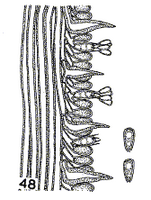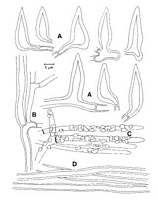|
 Phellinus kamahi Phellinus kamahi
SynonymsFuscoporia kamahi
Fomes nigrolimitatus
BiostatusPresent in region - Indigenous. Endemic
Images (click to enlarge)
Caption: Fuscoporia kamahi x 600, spores x 1200. Section through part of a dissepiment showing small setae of irregular shape and obovate apiculate spores.
Owner: Cunningham, G.H. | 
Caption: Fig. 8. Phellinus kamahi. A, setae; B, generative hyphae with part of skeletal hyphae; C, encrusted
hyphae from the dissepiments; D, skeletal hyphae. From the type of Fuscoporia kamahi (PDD
5850). |
Article: Cunningham, G.H. (1965). Polyporaceae of New Zealand. New Zealand Department of Scientific and Industrial Research, Bulletin 164: 304 p. Wellington:.
Description: Hymenophore perennial, stratose, adherent, woody, effused forming irregularly elliptical areas 12-30 x 5-12 cm, sometimes extending to 1.25 m, 2-8 mm thick. Hymenial surface bay, becoming ferruginous or umber, even, scantily or not creviced; margin receding with each layer, thinning out, at first fulvous, drying ferruginous, fibrillose, then even. Pores in 1-3 layers, round, 6-7 per mm, 75-150 µm diameter, 1-6 mm deep in each layer; dissepiments 50-100 µm thick, equal. Context ferruginous, 0.2-1 mm thick, of closely intertwined hyphae; skeletal hyphae to 4 µm diameter, walls 1 µm. thick, chestnut, aseptate, sparsely branched near ends; generative hyphae to 2.5 µm diameter, walls 0.1 µm thick, branched, septate, hyaline or tinted. Hymenial layer to 15 µm deep, a dense palisade of setae, basidia and paraphyses. Setae narrowly ventricose, some subulate, 20-26 x 6-8 µm, rarely to 30 µm long, walls chestnut. Basidia oblong or clavate, 8-10 x 4-5 µm, bearing 4 spores; sterigmata erect, to 4 µm long. Paraphyses subclavate or oblong, 6-8 x 3.5-4.5 µm. Spores narrowly obovate, apiculate, 4-6 x 1.5-2 µm, walls smooth, hyaline, 0.1 µm thick.
Habitat: Bark of fallen trunks and branches, associated with a white rot.
Distribution: New Zealand.
Notes: Specific features are the narrow setae of moderate size, narrowly obovate apiculate spores, small pores and vaguely stratose fructifications ferruginous when fresh, becoming discoloured and sometimes black when old. Some specimens extend for more than one metre on sides of fallen logs. Commonly of one layer to 6 mm thick, extensive specimens may attain a thickness of 12 mm and consist of two or occasionally three layers, sometimes clearly defined with colour zones between, at others only vaguely defined, occasionally with a delicate layer of context hyphae. In old specimens pores may be stuffed and sometimes the upper part of dissepiments indurated and impregnated with a resinous material so that tissues are firm and woody and the colour changes to black. Setae are slightly smaller in collections from Dysoxylum spectabile, but spores and other features are the same as in the type. The name of the species is taken from the Maori name, kamahi, of one host, Weinmannia racemosa, on which the species is abundant throughout New Zealand. Formerly I described the species under the name of Fomes nigro-limitatus (Rom.) Egel. (Cunningham 1948g, p. 9). It differs in colour, fewer strata, skeletal hyphae, smaller setae, differently shaped spores and in being completely resupinate. `F.' nigro-limitatus is confined to conifers and produces a conspicuous white pocket rot in its hosts.
Article: Buchanan, P.K.; Ryvarden, L. (1988). Type studies in the Polyporaceae - 18. Species described by G.H. Cunningham. Mycotaxon 31(1): 1-38.
Notes: This species belongs in Phellinus Quel., and is similar in colour and pore size to P. punctatiformis
(Murr.) Ryv. However, the spores of P. kamahi are larger, 5-7(-8.5) x 2.5-3 µm, although
Cunningham (1965) described them as being 4-6 x 1.5-2 µm. A conspicuous feature of P. kamahi is
the coarse crystals encrusting generative hyphae at or near the pore mouths. Cystidioles, present in
the hymenium, are hyaline, thin-walled, lageniform and often have elongated, tapering necks.
|